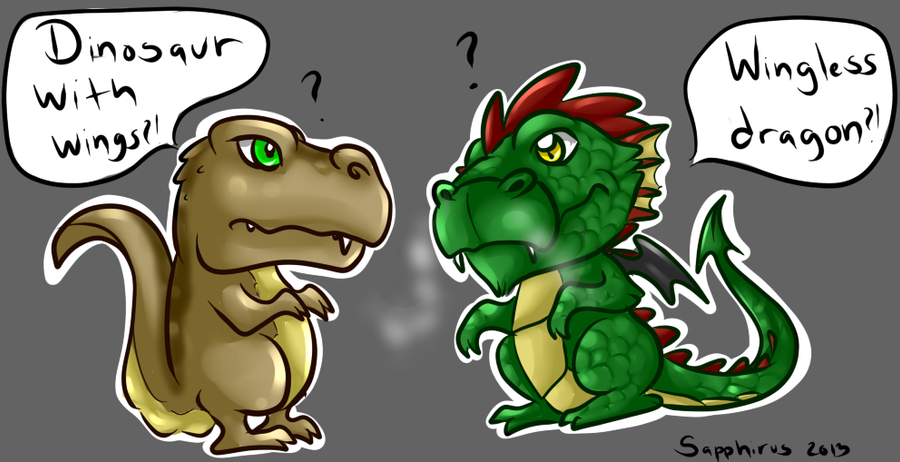Devils and Dragons (original) (raw)

I’ve seen several references to the Bible containing dragons, which some Creationists have tried to link to dinosaurs. Never mind that dinosaurs and dragons don’t have a whole lot in common, other than being at least somewhat reptilian.
Source
Dragons, like most other mythological beings, seem to be a combination of traits from animals that the writers of legends would have been familiar with. Besides, I’d say there’s really only ONE dragon in the Bible, and even that might not be as straightforward as it seems. The Hebrew word used in the Old Testament that is often translated as “dragon” is tannin, which can refer to any kind of land or sea monster. Genesis 1:21 uses the same word in the plural, only here the King James Version translates it as “great whales.” On the other hand, Revelation does indeed use the word drakon to describe the form Satan takes. Again, a drakon isn’t necessarily one specific kind of animal, but it usually referred to serpents. Indeed, a lot of early depictions of dragons make them more like snakes than lizards, and certainly not at all like any known dinosaurs. There are many different kinds of dragons in myth and legend, and the ideas changed quite a bit over time, and after exposure to other kinds of similar monsters from different parts of the world. Flaming breath was associated with Humbaba in the Epic of Gilgamesh and the Chimera in Greek mythology before being transferred to more reptilian creatures.
The dragon in Revelation actually spews water from its mouth, which would presumably be of use if it ever had to go up against any of the fire-breathers.
This dragon has seven heads and ten horns, probably representing the seven hills of Rome and ten of its emperors (exactly which ones is a matter of some debate).
We also know that he’s red in color, but I don’t think whether he has legs or wings is ever specified.
In Revelation 12:9, we read, “And the great dragon was cast out, that old serpent, called the Devil, and Satan, which deceiveth the whole world: he was cast out into the earth, and his angels were cast out with him.” I believe the word here translated as “serpent” is is in the original Greek ophis, indicating a snake. And we all know that snakes have a bad reputation in mythology. While the words “snake” and “serpent” are basically interchangeable, I’ve always thought the latter word conjures a much more fearsome and impressive image, perhaps because of its use in the Bible. Since the serpent was cursed to crawl on its belly as punishment for tempting Eve, I’ve also long thought of a serpent as a snake with legs. The reference to Satan as “that old serpent” suggests a link to the talking snake of Genesis, an idea that likely dates to the period in between the two Testaments.
I believe the Wisdom of Solomon, which is dated to the second or first century BC, is the first known work to blame the Devil for what’s credited in Genesis to the snake.
Because John of Patmos went with that interpretation, it became typical in Christian belief, but I don’t think it’s that clear cut in Judaism. I have to say that the Genesis account has an element of Just So Story to it, essentially saying, “And that’s why snakes have to slither, and why people don’t like them.” For God to punish an entire suborder of animals for the actions of one already seems unfair, but it would be even more so if the Almighty knew that this one snake was possessed by Satan. And why point out that “the serpent was more subtil than any beast of the field which the Lord God had made” if it wasn’t supposed to have been in its own mind at the time? The association with Satan definitely seems to have been a later addition, from when the idea of the Devil was developing into something more like its present form. The association with dragons, however, might well come from Ladon, the serpent who guarded the apples of the Hesperides and was often referred to as a drakon. Ladon tried to prevent people from taking the fruit, rather than tempting than to do so, but was still a nasty snake on a fruit tree.
He was also sometimes said to have multiple heads, as many as one hundred of them.
Ladon was associated with the constellation Draco, which was wrapped around the North Star.
And that might have something to do with how dragons came to be associated with the Devil.
This entry was posted in Animals, Christianity, Greek Mythology, Judaism, Monsters, Mythology, Religion and tagged adam and eve, bible, chimera, creationism, devil, dinosaurs, draco, dragons, epic of gilgamesh, genesis, hesperides, humbaba, ladon, revelation, satan, serpents, snakes, tanninim, wisdom of solomon. Bookmark the permalink.